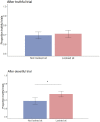Robot Gaze Behavior Affects Honesty in Human-Robot Interaction
- PMID: 34046585
- PMCID: PMC8144295
- DOI: 10.3389/frai.2021.663190
Robot Gaze Behavior Affects Honesty in Human-Robot Interaction
Abstract
As the use of humanoid robots proliferates, an increasing amount of people may find themselves face-to-"face" with a robot in everyday life. Although there is a plethora of information available on facial social cues and how we interpret them in the field of human-human social interaction, we cannot assume that these findings flawlessly transfer to human-robot interaction. Therefore, more research on facial cues in human-robot interaction is required. This study investigated deception in human-robot interaction context, focusing on the effect that eye contact with a robot has on honesty toward this robot. In an iterative task, participants could assist a humanoid robot by providing it with correct information, or potentially secure a reward for themselves by providing it with incorrect information. Results show that participants are increasingly honest after the robot establishes eye contact with them, but only if this is in response to deceptive behavior. Behavior is not influenced by the establishment of eye contact if the participant is actively engaging in honest behavior. These findings support the notion that humanoid robots can be perceived as, and treated like, social agents, since the herein described effect mirrors one present in human-human social interaction.
Keywords: deception; eye contact; gaze; honesty; human-robot interaction.
Copyright © 2021 Schellen, Bossi and Wykowska.
Conflict of interest statement
The authors declare that the research was conducted in the absence of any commercial or financial relationships that could be construed as a potential conflict of interest.
Figures




Similar articles
-
Directing Attention Through Gaze Hints Improves Task Solving in Human-Humanoid Interaction.Int J Soc Robot. 2018;10(3):343-355. doi: 10.1007/s12369-018-0473-8. Epub 2018 Apr 6. Int J Soc Robot. 2018. PMID: 30996753 Free PMC article.
-
Making eye contact with a robot: Psychophysiological responses to eye contact with a human and with a humanoid robot.Biol Psychol. 2021 Jan;158:107989. doi: 10.1016/j.biopsycho.2020.107989. Epub 2020 Nov 17. Biol Psychol. 2021. PMID: 33217486
-
I Reach Faster When I See You Look: Gaze Effects in Human-Human and Human-Robot Face-to-Face Cooperation.Front Neurorobot. 2012 May 3;6:3. doi: 10.3389/fnbot.2012.00003. eCollection 2012. Front Neurorobot. 2012. PMID: 22563315 Free PMC article.
-
The Influence of Culture on Attitudes Towards Humanoid and Animal-like Robots: An Integrative Review.J Nurs Scholarsh. 2018 Nov;50(6):653-665. doi: 10.1111/jnu.12422. Epub 2018 Sep 21. J Nurs Scholarsh. 2018. PMID: 30242796 Review.
-
Human-Robot Interaction: Status and Challenges.Hum Factors. 2016 Jun;58(4):525-32. doi: 10.1177/0018720816644364. Epub 2016 Apr 20. Hum Factors. 2016. PMID: 27098262 Review.
Cited by
-
Robot's Social Gaze Affects Conflict Resolution but not Conflict Adaptations.J Cogn. 2022 Jan 6;5(1):2. doi: 10.5334/joc.189. eCollection 2022. J Cogn. 2022. PMID: 36072111 Free PMC article.
-
Coordinating With a Robot Partner Affects Neural Processing Related to Action Monitoring.Front Neurorobot. 2021 Aug 11;15:686010. doi: 10.3389/fnbot.2021.686010. eCollection 2021. Front Neurorobot. 2021. PMID: 34456705 Free PMC article.
-
Does a robot's gaze aversion affect human gaze aversion?Front Robot AI. 2023 Jun 23;10:1127626. doi: 10.3389/frobt.2023.1127626. eCollection 2023. Front Robot AI. 2023. PMID: 37427087 Free PMC article.
References
-
- Bennett C. C., Šabanović S., Fraune M. R., Shaw K. (2014). Context congruency and robotic facial expressions: do effects on human perceptions vary across culture?, in Robot and Human Interactive Communication, 2014 RO-MAN: The 23rd IEEE International Symposium (Edinburgh: ), 465–470. 10.1109/ROMAN.2014.6926296 - DOI
-
- Burnham T. C. (2003). Engineering altruism: a theoretical and experimental investigation of anonymity and gift giving. J. Econ. Behav. Organ. 50, 133–144. 10.1016/S0167-2681(02)00044-6 - DOI
LinkOut - more resources
Full Text Sources
Other Literature Sources
Research Materials

